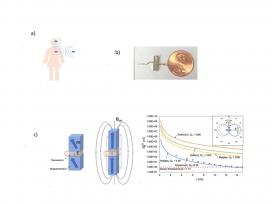An Electrically Small Magnetic Antenna for Implantable Medical Devices
Researchers at the NSF-funded Engineering Research Center for Translational Applications of Nanoscale Multiferroic Systems (TANMS), headquartered at UCLA, have made a groundbreaking achievement in the development of an internal antenna designed for a wide range of devices to be used within the human body. This antenna serves as a substitute for currently embeddable devices like pacemakers that require an antenna. The recently demonstrated antenna, known as a magnetoelectric antenna, utilizes electric fields to generate magnetic signals for communication through the dielectric-cluttered body, as opposed to relying on lossy electrical currents. This novel approach represents a significant improvement over existing pacemaker antenna technology, as it utilizes magnetic fields for communication instead of less efficient electric current-generated electric fields employed by conventional antennas, which struggle to penetrate deep into the human anatomy. Furthermore, this device relies on mechanical-based physics rather than electromagnetic, allowing for the production of significantly smaller devices that naturally resonate. Moreover, this innovative approach offers the potential for wireless energy transfer to the device, eliminating the need for an onboard battery and replacement.
Magnetoelectric antennas offer substantial benefits as communication devices, especially due to their compact size and enhanced efficiency compared to existing antenna technologies—i.e., orders of magnitude smaller. However, the significance of magnetoelectric antennas goes beyond these advantages, as they introduce a fundamental shift in the way we communicate. By utilizing magnetic signals instead of electrical signals, magnetoelectric antennas address crucial concerns associated with traditional communication methods. Electrical signals tend to dissipate energy rapidly in mediums like seawater and the human body, leading to communication difficulties and potential health hazards. These hazards range from energy absorption by the body, which can cause tissue heating and damage, to neurological issues like dizziness or confusion. With the adoption of magnetoelectric antennas, these health risks can be eliminated, opening doors to improved medical data collection and more accurate diagnostics. As users, as industries, and in society as a whole, we stand to gain safer and more efficient communication systems, empowering healthcare professionals to deliver better care while safeguarding patient well-being.
Magnetoelectric antennas represent an innovative advancement in communication technology, utilizing a combination of piezoelectric and magnetostrictive materials to create a novel antenna design. The operation of these antennas involves the application of a voltage to a piezoelectric actuator’s electrodes, inducing strain that is subsequently transferred to the magnetostrictive material, thereby generating a magnetic field. To ensure antenna reliability and performance, extensive modeling was carried out, meticulously accounting for external factors that could potentially affect the measured magnetic fields.
A series of experiments were conducted to evaluate the potential of magnetoelectric antennas, with a primary focus on characterizing signal strength. The results demonstrated performance comparable to that of the initial pacemaker antenna of the magnetoelectric device, indicating promising outcomes. However, these experiments also highlighted areas that could be significantly improved. Notably, replacing the current Metglas magnetostrictive material with Terfenol-D could reduce the antenna's volume by a remarkable factor of 4500 without compromising signal strength.
The objective of this research was to develop a communication device that would overcome the limitations of conventional communication through the body, while further miniaturizing the antenna for potential applications in a wide range of embeddable devices beyond pacemakers. Through dedicated research and development efforts, the magnetoelectric antenna has proven its transformative capabilities in revolutionizing communication methods. By harnessing the distinctive properties of piezoelectric and magnetostrictive materials, it provides a highly efficient and dependable means of communication.


